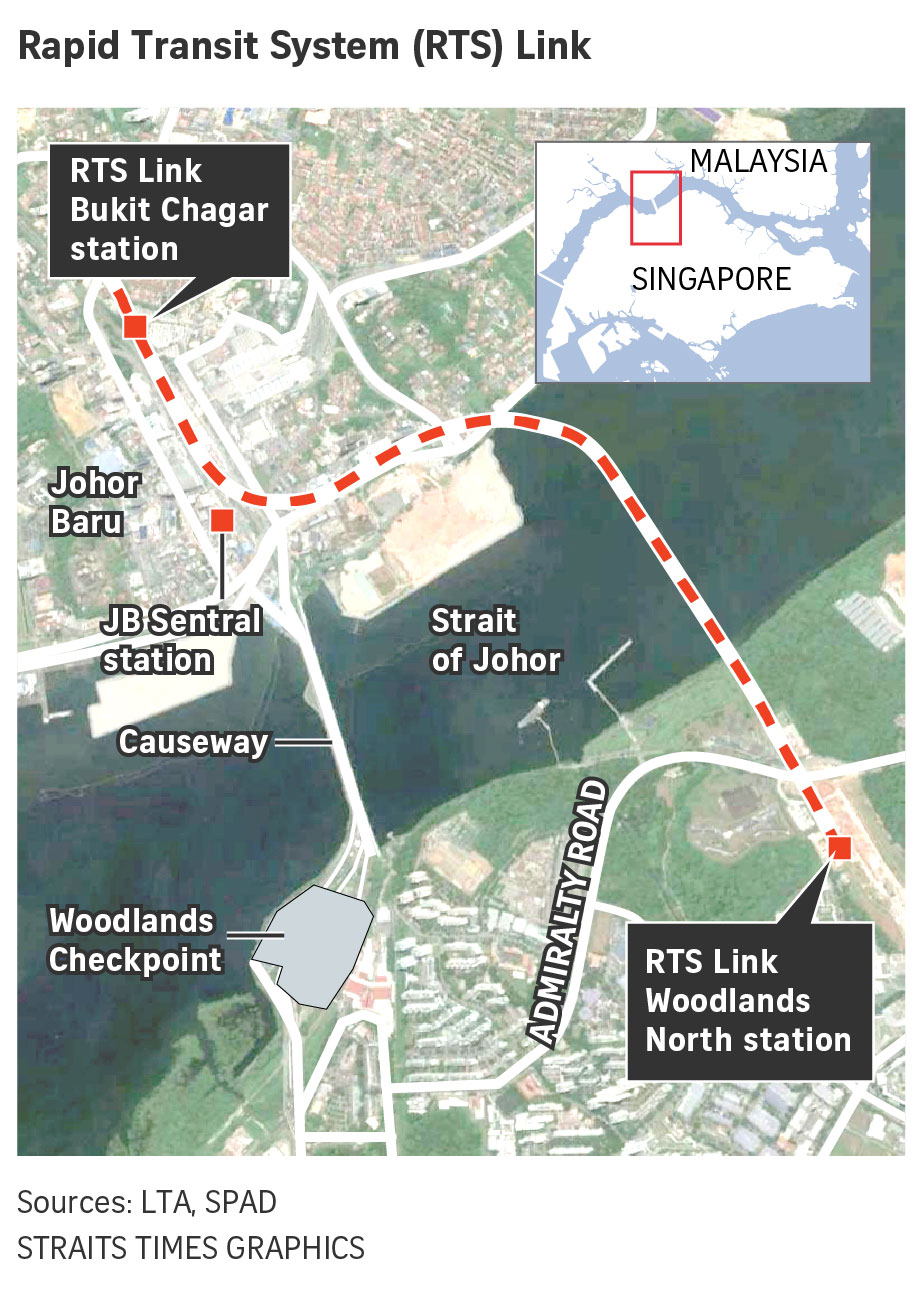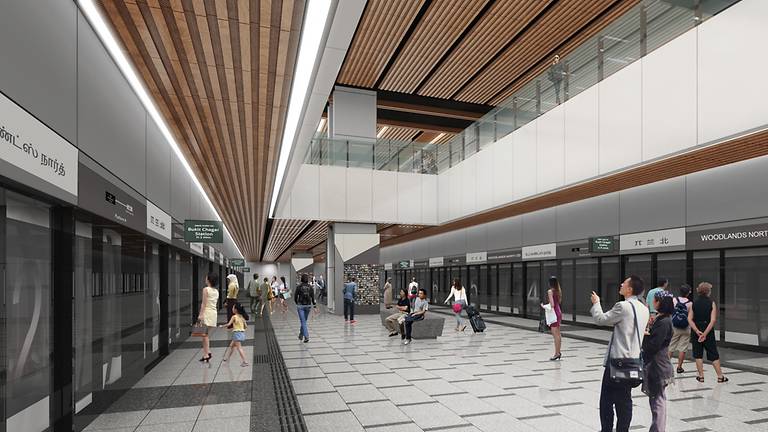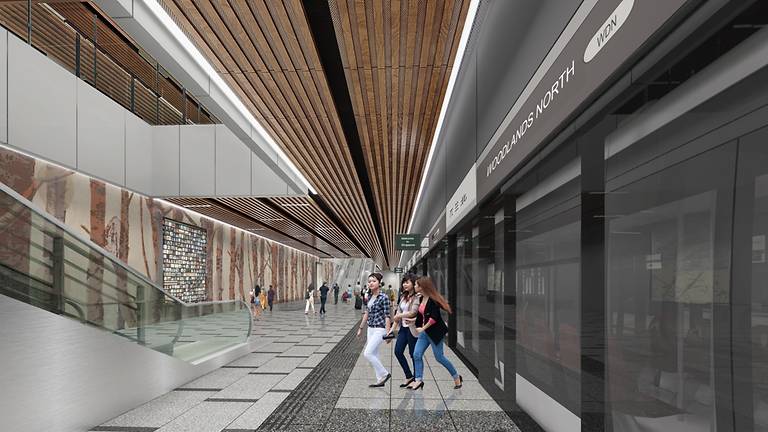



Singapore, Malaysia sign bilateral agreement on Johor Bahru-Singapore Rapid Transit System(RTS)
SINGAPORE: A legally binding agreement between Singapore and Malaysia brings the Johor Baru-Singapore Rapid Transit System Link (RTS Link) one step closer to fruition.
The bilateral agreement was signed on Tuesday (16th Jan 2016) by Singapore Transport Minister and Coordinating Minister for Infrastructure Khaw Boon Wan and Malaysia's Minister in the Prime Minister's Department Abdul Rahman Dahlan.
The signing was witnessed by Singapore Prime Minister Lee Hsien Loong and his Malaysian counterpart Najib Razak during the 8th Singapore-Malaysia Leaders' Retreat.
In a joint media release, Malaysia's Land Public Transport Commission (SPAD) and Singapore's Land Transport Authority (LTA) welcomed the signing, saying it signifies a firm commitment to an important project that will benefit both countries.
It said the agreement is the outcome of extensive discussions led by officials from SPAD and LTA. "It captures the key points of agreement on the RTS Link project, including the technical, safety and security requirements, commercial, financing, procurement and regulatory frameworks, as well as customs, immigration and quarantine arrangements," the release added.
Land Public Transport Commission (SPAD) Chief Executive Officer, Mohd Azharuddin Mat Sah, said the project, which is scheduled to begin construction in 2019, would be able to reduce traffic congestion by up to 15 per cent once it begins operation by end-2024. When completed by 2024, the RTS Link will be able to carry up to 10,000 passengers in each direction every hour. This translates to an additional capacity of 60,000 users crossing the causeway during peak hours.
The RTS Link will have the capacity to carry up to 10,000 passengers per hour per direction (pphpd) or 72,000 passengers daily, which translates to an additional capacity of 60,000 users crossing the Causeway during peak hours as compared to the average of 300 pphpd currently.
Until the RTS Link becomes operational, the frequency of the KTMB shuttle services between Singapore and Johor Baru will be increased, PM Lee said at the joint press conference after the Singapore-Malaysia Leaders' Retreat.
Mr Najib indicated that the KTMB's current 26 daily trips between Johor Baru and Singapore could be raised in future.
"I really appreciate the decision by the Singapore government to allow the KTM shuttle service to be increased. It has increased now to 26, and there's a proposal for it to go up to 31 in the near future and certainly this will be helpful," Mr Najib said.
For ease of commute, the RTS Link will have co-located Custom, Immigration and Quarantine (CIQ) facilities in both the Bukit Chagar station in Johor Baru and Woodlands North station in Singapore.
"Passengers travelling in either direction will clear both Malaysia and Singapore authorities at the point of departure, and need not go through immigration clearance again at the point of arrival," the statement said.
ROUTE, MAINTENANCE AND APPOINTMENT OF INFRASTRUCTURE COMPANIES

The media release also said the service will cross the Straits of Johor via a 25-metre high bridge linking both the stations. It said the RTS Link will utilise the same "four core systems" as the upcoming Thomson-East Coast Line (TEL). These systems include the same trains, signalling system, communications system and the Integrated Supervisory Control System.
Heavy maintenance will be outsourced to SMRT Trains, which will operate TEL. This will be done at its Mandai Depot, although there will also be a light maintenance facility at Bukit Chagar.

Each country will appoint an Infrastructure Company (InfraCo) to fund, build, own, maintain and renew the civil infrastructure and stations within their territories. In Malaysia, the InfraCo will be Prasarana Malaysia Berhad, while LTA will be Singapore's InfraCo.

Both governments will also jointly appoint an operating company (OpCo) to own, design, build, finance, operate, maintain and renew the RTS Link's operating assets such as trains, tracks and systems.
The OpCo will pay a concession fee to the two countries in exchange for the right to collect fare revenue from operating the Link. The authorities said fares will be set on a commercial basis by the OpCo and not regulated by the two governments.
Under the terms of the agreement, the OpCo for the first concession period of 30 years, will be a joint venture between a Malaysian and a Singaporean company. These companies are Prasarana from Malaysia and SMRT Corporation in Singapore. "The companies have committed to incorporate the JV (Joint Venture) by 30 June 2018, and to sign the concession agreement by 30 September 2018. Subsequent concessions will be awarded through open tender," the statement said.
7 things to know about the upcoming Johor Baru-Singapore Rapid Transit System Link
1. THERE WILL BE A TRAIN EVERY 8 MINUTES
When it is ready by Dec 31, 2024, commuters can hop on a train every eight minutes on average. Trains will eventually arrive every four minutes on average during peak periods. The line will start with five trains, and gradually have a total fleet of seven trains. The link can carry up to 10,000 passengers per hour in each direction. This means 60,000 additional commuters will be able to cross the Causeway during peak hours. Currently, an average of 300 passengers travel in each direction per hour using the daily shuttle train service between Woodlands and Johor Baru.
2. START YOUR JOURNEY AT WOODLANDS NORTH
The line will link Bukit Chagar station in Johor Baru, near Sentral train station, to the Singapore terminus in Woodlands North, where commuters can transfer to the upcoming Thomson-East Coast MRT Line (TEL). The TEL is expected to open in phases from 2019 to 2024, and will comprise 31 stations stretching from Woodlands in the North to Sungei Bedok.
3. PASSENGERS NEED TO CLEAR CUSTOMS ONLY ONCE
The link will have a joint customs, immigration and quarantine facility at both terminus stations. Passengers who are crossing the border will need to clear customs and immigration only when they depart from either Singapore or Malaysia.
4. THE 4KM LINK WILL CROSS THE STRAITS OF JOHOR VIA A 25M-HIGH BRIDGE
The tracks will cross the Strait of Johor in a straight line rather than curving over water, taking into account the Johor Sultan's earlier reservations about the project. It will make a bend over land in Malaysia instead.
5. FARES WILL BE SET BY JOINT VENTURE COMPANY
Fares will be set by the joint venture company between SMRT and Prasarana Malaysia. It will not be regulated by the two governments.
6. THE END OF KTM SHUTTLE TRAIN
Within six months after the link starts operations, the Keretapi Tanah Melayu Tebrau (KTM) Shuttle will cease. The KTM train service has been running 26 daily trips since June 1 last year to cope with higher demand.
7. POSSIBLE REDEVELOPMENT OF WOODLANDS CHECKPOINT
Last August, Mr Khaw said the opening of the link will allow the Woodlands Checkpoint to be redeveloped, after the train shuttle service ends and land is freed up. "Then, hopefully, this problem of the Causeway jam can be significantly mitigated or even eliminated," he had said.